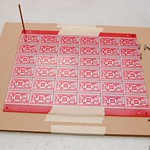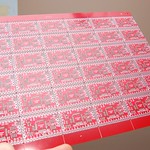
I’ve been doing all manual SMD assembly ever since I started Low Power Lab, and still do at this moment. I find it too hard to outsource assembly and too prone to some issues.
Anyway, in the beginning there were tweezers, a microscope, and a toaster over for reflowing. I very quickly realized that the tweezer method was insane to put it mildly, the only worst thing that I can think of is actually soldering everything with a soldering iron instead of using paste. Nonetheless the first ever Moteino batch was tweezer-microscope+reflow assembled. Then I figured out how to make metal stencils out of soda cans. That works beautifully, costs next to nothing, and the more you make the faster and better it gets, and those stencils never wear out, unlike mylar or other plastic stencils. It’s the closest you will get to real stainless steel stencils. But I could only spread paste on 1 piece and it gets tedious, watch this video of how I actually do it. Panelizing PCBs sounded a bit scary.
So finally I made the jump and panelized a batch of Moteinos recently. The panel has 2.5mm tooling holes that are spaced on a NxN cm grid (which would fit the Stencil8 tooling block), but quite frankly they could be spaced any way. The tooling holes match holes in the stencil such that the stencil alings perfectly with the PCB. The panels and stencils are made at Hackvana. I don’t have a tooling block because quite frankly I don’t think it’s needed (UPDATE: I actually had a MDF block milled – see this post for details). I drilled holes in some MDF using a 2.5mm drill bit (the thin sheets that come with the stencil are right size and perfect for the job), using the PCB to pilot the holes. Then 2.5mm steel tooling pins align the stencil with the PCB.
 |  |  |  |
The time savings is significant, especially if multiple panels are assembled at once. I was reluctant at first and I was worried about the spacing between the PCBs and other things like that. But glad I did it and this is a first step towards more serious in house assembly. The v-scoring means the PCBs are snapped apart after reflowing, and the edges will be a bit rougher than the nicely routed PCBs I was used to. I do however snap the panels in 3 rows for easier SMD assembly with my pick and place vacuum tool. After reflow they are snapped into individual pieces. The panelization is done at the PCB fab for an extra fee.
The McMasterCarr parts for the pins and the drill bit are: here for the pins and here for the drill bit.
Next up: pick and place machine maybe? Haha.

What is the metal stencil made of? Very nice looks to be a great improvement in efficiency.
Laser cut stainless steel. Yes it’s quicker to lay paste on a bunch of boards but needs thorough cleaning of the apertures otherwise the next batch will have a poor paste trasfer. Electropolished stencils help to smooth aperture walls and leave less paste residue behind but they are more expensive and typically used only for fine pitch components.
I never realised they were hand built! They are so clean I could have sworn they were P+P’d credit to your skill and a steady hand.
It seems only logical to go for a P&P system, maybe even outsourcing your production. DFM is a field of it’s own, but oh so much fun. Also if you want to outsource your production, that would be a load off of your shoulders for sure!
I googled around and found a P&P facility in Michigan, so here’s a link http://www.maksinc.net/request-quote.html
Dave from EEV blog made some good videos on DFM
https://www.youtube.com/watch?v=VXE_dh38HjU
(links to the rest are in the description)
If you want to look at getting your own P&P machine, there’s some cheap ebay ones, that work rather well, they however don’t have any optical alignment system, so it’s all down to it starting correctly:
Scratch that, they all dissapered from ebay. deh fak?
Well they are still on aliexpress (kinda the same)
http://www.aliexpress.com/item/Surface-Mount-System-Desktop-Pick-and-Place-Machine-SMT-0605-TM220A/1037466853.html
They are expensive, yeah. But cheap compared to professional P&P machines
Thanks for the tips. I have researched P&P for many months now. Outsourcing at my volume would be a huge hassle and huge cost as well. I need very quick turn around. So unless I make a million of these, it makes no sense to outsource. In house production will ensure the prices will be kept under control. More about this subject later.